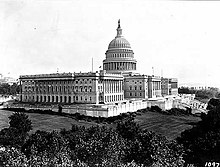Fifty-sixth Congress
| 56th United States Congress | |
|---|---|
|
55th ←
→ 57th
|
|

United States Capitol (1906)
|
|
| March 4, 1899 – March 4, 1901 | |
| Senate President |
Garret Hobart (R) until November 21, 1899 Vacant from November 21, 1899 |
| Senate Pres. pro tem: | William P. Frye (R) |
| House Speaker: | David B. Henderson (R) |
| Members: | 90 Senators 357 Representatives 4 Non-voting members |
| Senate Majority: | Republican |
| House Majority: | Republican |
| Sessions | |
|
1st: December 4, 1899 – June 7, 1900 2nd: December 3, 1900 – March 3, 1901 |
|
The Fifty-sixth United States Congress was a meeting of the legislative branch of the United States federal government, composed of the United States Senate and the United States House of Representatives. It met in Washington, DC from March 4, 1899 to March 4, 1901, during the third and fourth years of William McKinley's presidency. The apportionment of seats in this House of Representatives was based on the Eleventh Census of the United States in 1890. Both chambers had a Republican majority. There was one African-American member, George Henry White of North Carolina, who served his second and final term as a Representative in this Congress, and would be the last black member of Congress until 1928, and the last black member of Congress from the South until 1972.
The count below identifies party affiliations at the beginning of the first session of this Congress, and includes members from vacancies and newly admitted states, when they were first seated. Changes resulting from subsequent replacements are shown below in the "Changes in membership" section.
This list is arranged by chamber, then by state. Senators are listed by class, and Representatives are listed by district.
At this time, Senators were elected by the state legislatures every two years, with one-third beginning new six-year terms with each Congress. Preceding the names in the list below are Senate class numbers, which indicate the cycle of their election. In this Congress, Class 1 meant their term began with this Congress, requiring re-election in 1904; Class 2 meant their term ended with this Congress, requiring re-election in 1900; and Class 3 meant their term began in the last Congress, requiring re-election in 1902.
The count below reflects changes from the beginning of the first session of this Congress.
Lists of committees and their party leaders.
...
Wikipedia
